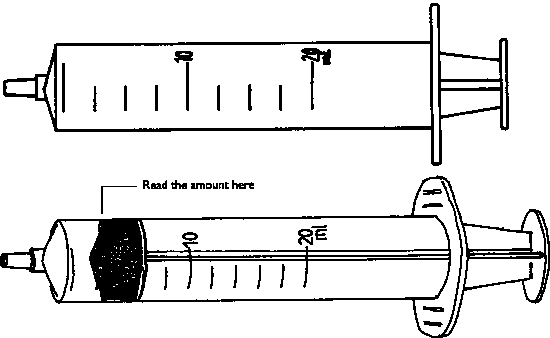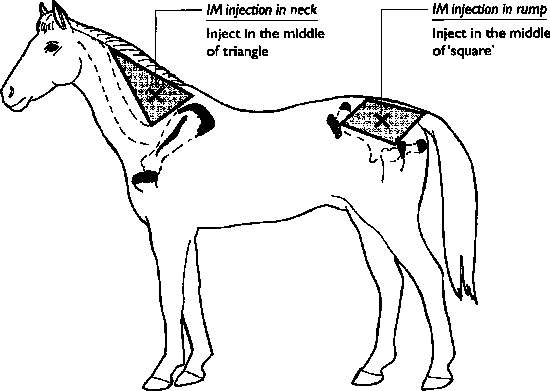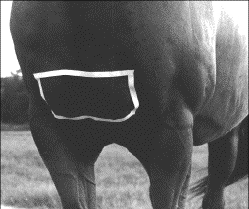Some medications in horses need to be given by injection. We may ask you to give these medications if we and you believe that you are safe and confident to do so.
If you have any questions or concerns bout giving medications, please do ask us for advice.
1) Ensure that any medications, syringes and needles are stored safely and out of reach of children (some must be kept refrigerated)
2) Ensure you know which site you are injecting. Intra-muscular injections can be given into the neck, rump or chest. See the diagrams for details.
3) Each time you treat the horse:
- Ensure the horse's skin is clean and dry at the injection site
- Use a new syringe and needle on each occasion
- Draw up the dose you have been instructed to give:
- Shake the bottle gently to ensure it is well mixed
- Attach the clean needle to the syringe (hold the needle by the needle cover). Remove the cover then introduce the needle into the bottle through the rubber bung in the bottle (this should be clean)
- Turn the bottle upside down. Ensure the needle tip is below the surface of the liquid in the bottle (you may need to withdraw the needle slightly from the bottle)
- Pull back on the syringe plunger to fill the syringe to the required level. Read the level from the top of the back rubber syringe stopper. If this is difficult, you may need to inject a little air into the bottle

- Remove the needle and syringe from the bottle. Hold the syringe upright. Expel any air from the top of the syringe and check that you have drawn up the correct dose
Inject at the required site:
- i) Ask a competent handler to hold the horse
- ii) Pinch the skin next to the injection site (neck) or tap the area a couple of times (rump or chest) so the injection is not a complete shock for the horse
- iii) Confidently insert the needle straight into the muscle right up to the hub. Sometimes it is easier to remove the needle from the syringe to do this, then reattach the syringe
- iv) Draw back gently with the syringe plunger to check the needle is not in a blood vessel (look for blood appearing in the needle hub or front of the syringe). If the needle is in a blood vessel is should be withdrawn and redirected
- v) Inject the medication by pressing the syringe plunger. If injecting more than 20mls, you should redirect the needle during injection
- Remove the syringe and needle. It may help to apply some pressure to the injection site to prevent bleeding.
Please dispose of the needle in a sharps container or keep these in a safe place in a solid container, such as an old margarine tub. Please keep syringes separately and return both to one of our vets for safe disposal.
GENERAL TIPS:
- Alternate from side to side (and different sites if necessary) to prevent the horse from getting too sore in one place
- Monitor the injection sites for any pain or swelling and contact us if you have any concerns
INJECTION SITES FOR INTRA-MUSCULAR INJECTIONS IN HORSES:
Be aware that horses may strike out with the front legs or rear when injected in the chest or neck, and may kick out when injected in the rump. You and handlers must position yourselves appropriately and protective clothing (for instance a riding hat) may be required
NECK AND RUMP INJECTION SITES:

CHEST / PECTORAL INJECTION SITE:

